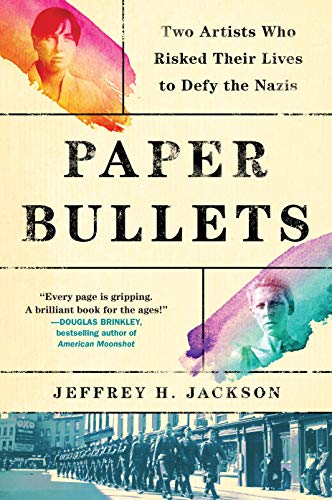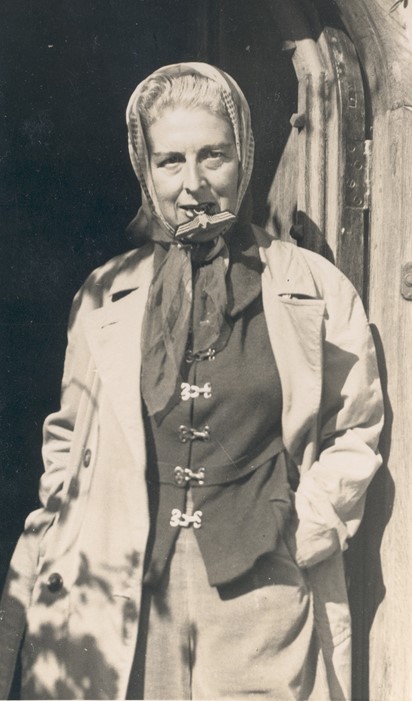 PAPER BULLETS
PAPER BULLETS
Two Artists Who Risked Their Lives to Defy the Nazis
by Jeffrey H. Jackson
Algonquin Books. 330 pages, $27.95
MANY YEARS AGO, at the University of Paris, I took a course on André Breton and Surrealism. We learned Lautréamont’s famous line about the chance encounter of an umbrella and a sewing machine on an operating table, and how such uncustomary juxtapositions could challenge the observer’s preconditioned perceptions of reality to the point that—as Breton argued in his two Surrealist Manifestos (1924, 1930)—they jar us from our habitual ways of seeing the world and force us to perceive things in whole new ways.
I appreciated some of the art inspired by this movement, such as the paintings of Salvador Dalí, but I never bought the argument that art presenting random juxtapositions of objects could really bring about such an epiphany. In the era of Timothy Leary and hallucinogenic drugs, a sewing machine and an umbrella on an operating table just didn’t seem all that destabilizing. Like other movements that have emerged from Paris since then, some of the art was convincing, its theoretical underpinnings less so.
Others, however, were persuaded. Among them was the minor French writer and photographer Lucy Schwob, better known by her gender-ambiguous pseudonym Claude Cahun (1894–1954), and her lover Suzanne Malherbe, a.k.a. Marcel Moore (1892–1972). Their wartime activities on the English Channel’s Isle of Jersey are the focus of Paper Bullets, with its misleadingly overblown subtitle, “Two Artists Who Risked Their Lives to Defy the Nazis.”
Schwob and Malherbe were products of two provincial bourgeois families. They grew up together in Nantes around the turn of the 20th century, and at some point they became lovers. Schwob began to wear gender-ambiguous clothes and close-cropped hair. In 1920, by then in their late twenties, they moved to Paris, then truly the capital of modern art and, in certain circles, of more liberal ideas on sexuality and relationships.
For the next two decades, they were able to meet some of the important innovators on the world art scene, such as Louis Aragon, Dalí, Aldous Huxley, Jean Cocteau, and Gertrude Stein. With her partner Alice B. Toklas, Stein provided Schwob and Malherbe with a model of how an artistically inclined lesbian couple could live together openly, albeit within a relatively small circle. They also knew another such couple, Sylvia Beach, owner of the Shakespeare and Company bookstore, and her partner Adrienne Monnier.
Schwob did not operate at that level of artistic achievement. She produced photographs that allowed her to play with images of gender fluidity but that do not seem to have attracted much attention. In Paper Bullets, author Jeffrey H. Jackson asserts that her memoir, Aveux non avenus (“Disavowals,” 1930), “captured the interest of many in the avant-garde art world in Paris,” but provides no supporting documentation. Breton wrote that he considered her “one of the most curious spirits (among four or five) of our times,” without referring to her work.

By the late 1930s, the climate in Paris started to change. Right-wing militias warred with the Left in the streets. In 1937, by then in their early forties, Malherbe and Schwob decided to move to the Isle of Jersey, even though it meant leaving the Paris art world and a more open society behind. On Jersey they lived largely in isolation from the local population and reverted to using their birth names. When the Allied defense against the invading Germans began to collapse in June 1940, the couple did not join the thousands who fled the island for (relative) safety in England. The Germans occupied Jersey without a fight but did not bother the two women, who continued to live in relative comfort.
Nor were they idle during this time. They began to create small, often Surrealist artworks—photographs with cryptic captions, strange poems in not-always-correct German—that they planted around the island. Schwob and Malherbe were convinced that their sometimes incomprehensible creations would appear to be the work of a disenchanted German soldier. It would therefore destabilize the occupiers’ belief in their mission, convincing them to abandon the fight. The two women operated in apparent ignorance of the resistance activity going on around them on the island and in northern France. Had they been aware of it, they most likely would not have joined. They had no interest in blowing up munitions depots or helping the Allies prepare their invasion. They wanted to use art to undermine German soldiers’ morale.
Jackson provides no evidence that even one German soldier took these minor artistic creations seriously or was influenced by them. Eventually, near the end of the Occupation, the German authorities did discover what the two women were doing and put them in the local jail. It appears that the Germans weren’t so much hunting for the women but only stumbled upon them and discovered what they were up to.
Thousands of men and women in Occupied Europe risked their lives to fight the Germans and prepare the way for the Allied invasion in 1944. Recently there have been fascinating books on the important roles played by women in the French Resistance. They did not have to tote guns or blow up bridges to provide crucial help. Still, to devote an entire, highly detailed book to the small-time, localized efforts of two evidently ineffective individuals strikes this reviewer as excessive. Even Jackson admits that “there were certainly no public signs that German morale was flagging” on Jersey while they distributed their creations.
The second half of the book is devoted to the trial of Schwob and Malherbe once they were caught. Jackson admits that “reconstructing this account of the trial required a great deal of assumption.” I often had the impression that I was reading, not what actually happened, but what the two women wanted the world to believe had happened.
Today, Schwob’s writings and photography have been resurrected by scholars who present them as early efforts to construct a lesbian identity. That they may be. As for the couple’s efforts to destabilize the German Army with offbeat images and texts, however, I kept imagining Josephine Hull and Jean Adair in Arsenic and Old Lace playing two kindly but somewhat batty old ladies. It was hard to take them or their project too seriously.
Richard M. Berrong, professor of French literature at Kent State University, is the author of Pierre Loti(2018).







Discussion1 Comment
This is an excellent article on the lives and work of Claude Cahun and Marcel Moore. I was particularly interested in learning about their time in exile in Jersey during WWII. It’s fascinating to think about how their relationship and work might have been